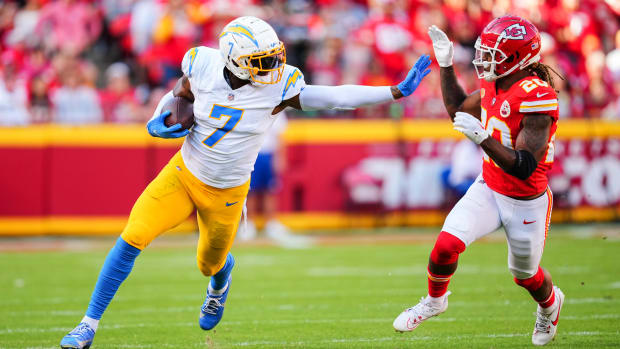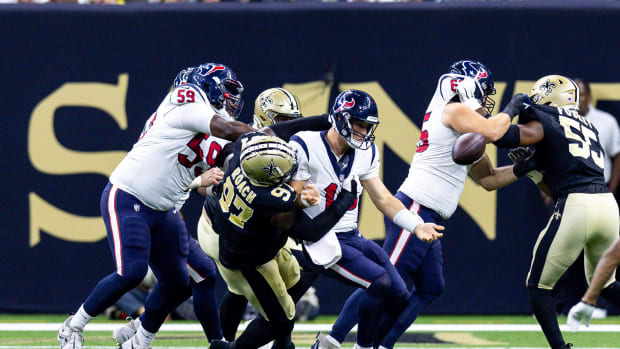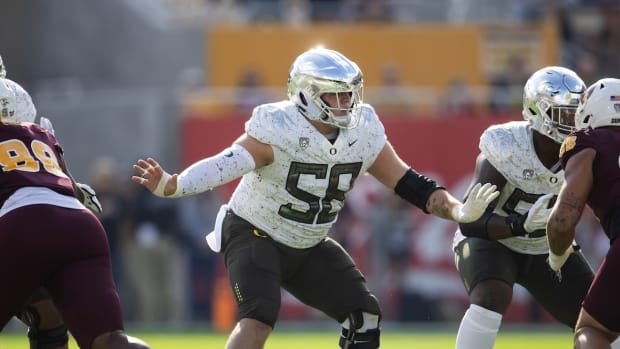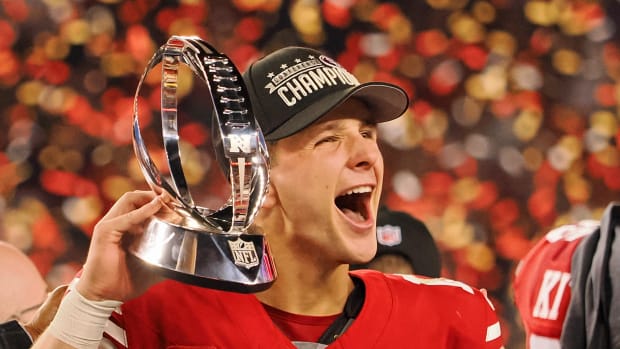
Bills Preview: Manuel Ready to Take on More
EJ Manuel started 10 games as a rookie, throwing 11 touchdowns and nine interception in accruing a 4-6 record. (Bill Wippert/AP)
They say if it ain’t broke, don’t fix it. But what if something unbroken has to be fixed anyway? Like when your defensive coordinator and several of his top assistants leave to take over the Cleveland Browns.
In the old Erie Canal port city 192 miles east of Cleveland, much of the focus has been on the passing of the local football team’s legendary owner, Ralph Wilson Jr., and the looming sale of the franchise. And any buzz not attributed to nerves over the club possibly leaving Western New York can be attributed to excitement over the arrival of Sammy Watkins.
Important as the rookie wideout is to a team that averaged just 194 yards a game through the air last season (28th in the NFL), the most significant change is at defensive coordinator. Twenty-four hours after Mike Pettine was hired in Cleveland, Jim Schwartz, fresh off a firing after five years as the head coach in Detroit, was tabbed to run the defense. Schwartz likely will replace Pettine’s hybrid, amoeba blitz-oriented scheme with a more traditional 4-3 zone scheme, featuring wide-9 defensive fronts and split-safety pre-snap looks. This for a defense that, after years of schematic overhauls, had finally become one of the most ascending units in football, ranking 10th in yards allowed last season.
Just because a stylistic change was unnecessary doesn’t mean it can’t still work. Most schemes, and especially a fairly simplistic, straightforward one like Schwartz’s, are as good as their lineup.
The Bills lineup looked a lot better before linebacker Kiko Alonso tore his ACL. Alonso, with his strong but fluid movement skills and high football IQ, was a budding star. He was scheduled to move to the weak side and be the key component of a revamped linebacking unit. Now in his stead will be third-round rookie Preston Brown, whose success might hinge on whether he can be a sound contributor in the nickel package.
Jim Schwartz is coordinating the Bills’ defense, after spending the past five seasons as the Lions’ head coach. (Bill Wippert/AP)
Filling the linebacking duties with Brown is ex-Patriot Brandon Spikes, the most vicious second-level run bomber in the NFL. Spikes’ aptitude for taking on lead-blockers is inversely proportionate to his dexterity in pass defense, which is why he’ll be supplanted in nickel packages. That duty likely will fall to smooth-moving veteran Manny Lawson, who is competing with talented journeyman Keith Rivers for the starting strongside backer job. After Spikes plays out his one-year, $3.25 million contract, the Mike duties will be bestowed—Buffalo hopes—upon Brown.
Smooth as Alonso’s path to stardom appeared to be, it’s nothing compared to cornerback Stephon Gilmore’s. If the third-year pro can stay healthy (he missed five games last season with a wrist injury), he’ll be a top-three corner, capable of shutting down opposing No. 1 receivers with minimal safety help, a la Darrelle Revis circa 2011. Gilmore has an innate sense for physicality and timing on the ball, which he most comfortably exhibits in press-man position outside. Schwartz would be wise amending his zone scheme to include more man concepts along the boundary, much like what Pete Carroll has done in Seattle.
The cornerbacks surrounding Gilmore could all handle more challenging man-based responsibilities. It took six years, but Leodis McKelvin has finally started to fulfill expectations that came with being drafted 11th overall in 2008. McKelvin is by no means a superstar cover corner, but he plays with gliding speed and a solid understanding of route concepts. Last season, he handled Steve Smith in iso-man coverage in Week 2 and did a terrific job downfield against Mike Wallace in Week 16. Inside, undrafted second-year man Nickell Robey has a chance to become a premiere slot corner, thanks in large part to his strength as a blitzer.
Given Robey’s assurgency, it’s surprising GM Doug Whaley signed ex-Ravens nickel corner Corey Graham to a four-year, $16 million contract this offseason. The money alone all but ensures Graham a nickel job, which means Schwartz is bound to replace Pettine’s three-safety dime package with a more old-fashioned four-corner dime package, setting up Robey to only play around 15 snaps a game.
The Bills pretty much have to play a four-corner dime, as the departure of Jairus Byrd leaves them with only two viable safeties ahead of last year’s mid-round picks Jonathan Meeks and Duke Williams. Slated to fill Byrd’s spot at free safety is Da’Norris Searcy, though given his susceptibility to play fakes as a deep defender, it might be better to play versatile fourth-year pro Aaron Williams in centerfield. That’d leave Searcy to man the box and cover tight ends, which he’s capable of doing. Williams is a converted corner with, by safety standards, superb cover skills. When asked to read-and-react in space, he’s performed well.
More Bills
Pittsford, N.Y., summer home of the Bills, was the first stop on The MMQB's 2014 Training Camp Tour.
Peter King:
Robert Klemko:
Though thin at safety, Buffalo’s back seven has a chance to be stellar if not spectacular. But it won’t matter if the front four can’t thrive. Schwartz’s scheme is dependent on penetration inside and corner-bending speed outside.
Penetration inside shouldn’t be a problem; Marcell Dareus, assuming he gets in shape, has proficient short-area quickness that can translate to gap-shooting adeptness. Veteran Kyle Williams, whom some have aptly described as a poor man’s Justin Smith, can excel in any scheme—and especially one that allows him to fire off the ball with low leverage. Williams has battled injuries in recent years, though aside from missing 11 games in 2011 he’s been able to stay on the field anyway. Nevertheless, it’s disconcerting that every defensive tackle behind the 31-year-old is undrafted, and the only one with meaningful NFL experience is Corbin Bryant.
Regarding the speed outside, one might assume that, because of his $96 million price tag and 23.5 sacks over two seasons in Buffalo, Mario Williams more than fits the bill. Williams, however, is a power-based end, relying less on raw speed and more on setting up opponents for bull-rushes and counter moves. That can work in Schwartz’s scheme (think of Williams as a more dynamic Kyle Vanden Bosch), but it’s imperative that Jerry Hughes, who will relieve light-footed 325-pounder Alan Branch on passing downs, display the sudden first step and relentless motor that helped him break out for 10 sacks last season. Working against Hughes is the fact that he’ll now operate with a hand in the dirt, which he never excelled at as a first-round bust in Indianapolis. Doug Whaley has also talked about Manny Lawson rushing from the edge on certain passing downs, but the 30-year-old former first-rounder has never materialized as that kind of player.
OFFENSE
Schwartz’s defense must prosper because the Bills are not equipped to win with offense. Obviously, Whaley and head coach Doug Marrone felt it was important to get better at wide receiver. They’ve clearly done that with the arrival of Sammy Watkins, and the hope is that troubled ex-Buc Mike Williams can recognize his potential after returning to play for the man whom he may or may not have walked away from at Syracuse four years ago. Williams is a dangerous though inconsistent downfield runner with potent elevation skills.
C.J. Spiller is averaging 5.1 yards per carry over his four-year career. (Bill Wippert/AP)
The rest of the receiving corps consists of last year’s second-round pick Robert Woods, last year’s third-rounder Marquise Goodwin and 2012’s third-rounder T.J. Graham. It’s a group that’s fast but callow. They’ll still get plenty of playing time, particularly Woods, who is the best route runner of the bunch. Barring a career resurgence by damaged ex-Chief Tony Moeaki, Buffalo’s only experienced option at tight end is veteran Scott Chandler, who seemed to have lost some of his athleticism coming off major knee surgery last season. Expect Marrone to once again feature three-receiver sets as the base offense.
Of course, receivers can only be as good as the man throwing them the ball. That’s where things get complicated. Or, actually, for the Bills, less complicated. With rookie EJ Manuel at the helm last season, Marrone ran a rudimentary offense. Manuel, said to be very bright, is presumably capable of learning any system. But executing is a whole different challenge. The 24-year-old must drastically improve his footwork and add more foundational fundamentals to support the physical strength and courage he exhibits when throwing with bodies around him. The more weaknesses Manuel can rectify, the less erratic his accuracy will be.
Though not quite as fleet-footed as other young mobile quarterbacks, Manuel can move. Hopefully this will lead to more rolled pockets in the passing game; in the running game, there’s no doubt Marrone will continue to incorporate a few read-option concepts to complement the viable one-two punch of C.J. Spiller and Fred Jackson. Both backs are in the final year of their contract (Spiller’s is a 2015 player option). Jackson, 33, is unlikely to return in 2015, which explains why Whaley reportedly tried to trade up to draft Carlos Hyde before ultimately trading a conditional pick next year for Philadelphia’s Bryce Brown. Spiller is the interesting case. Lateral quickness and breakaway speed make him a productive bouncer outside from spread sets. But a lack of durability has also pushed him to the edge of expendability.
Blocking for these men is a front five led by mobile, savvy center Eric Wood and 2012 second-round left tackle Cordy Glenn, who is coming off an up-and-down sophomore season. Between those two is athletic but underachieving guard Chris Williams, whom the Bills for some reason prized in free agency. On the right side, guard Kraig Urbik and especially tackle Chris Hairston are on notice; Whaley spent a fifth-round pick on guard Cyril Richardson and a second-rounder on mauling tackle Cyrus Kouandjio. The Bills also took a flyer on ex-Hurricane Seantrel Henderson, a first-round talent who fell to Round 7 because of character flags.
SPECIAL TEAMS
Undrafted Harvard man Jacob Dombrowski has a decent shot at winning the punting job given declining veteran Brian Moorman’s struggles. Last year’s sixth-round pick, Dustin Hopkins, is reportedly challenging for the kicking job, though it’s hard to imagine him unseating former Pro Bowler Dan Carpenter, who made 33 of 36 field goals in 2013. Buffalo’s return game is in good shape, as Leodis McKelvin, T.J. Graham, Robert Woods, C.J. Spiller and Marquise Goodwin are all dangerous.
BOTTOM LINE
The defense is improving, but with the scheme change and injury to Alonso, it’s hard to envision the unit as a whole being significantly better than it was a year ago. Which means the Bills are hinging a turnaround on their young quarterback—a tall order. A fourth-straight 6-10 campaign (and fifth in six years) seems likely.








































